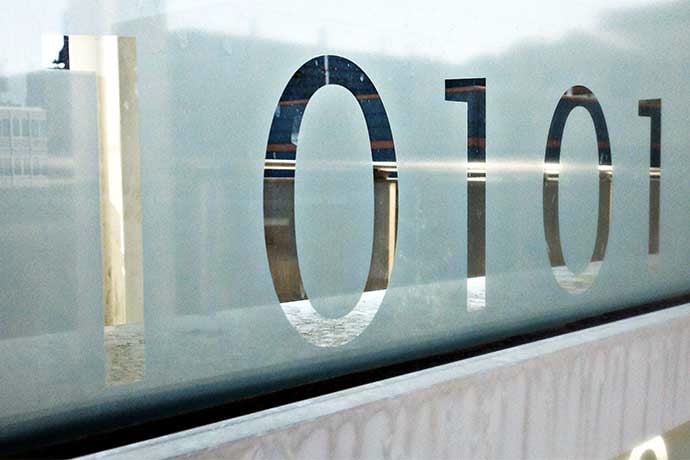When you see a letter T on your computer screen, did you know the computer doesn’t actually use the letter T? Instead, it uses a string of numbers, for example, 01010100. This is called a binary number because it uses two numbers, 0 and 1.
Computers transport, calculate, and translate binary numbers because computer hardware circuits only have two electrical states, on or off. These two states can be represented as zero (off) or one (on). All letters of the alphabet, numbers, and symbols are converted to eight (or more) character binary numbers as you work with them in software on your computer.
However, you can have fun with binary numbers without diving deeply into how computers translate binary numbers into letters, numbers, and characters.
How Binary Numbers Work
Here’s how simple binary numbers work. First, each position in a string of ones and zeroes represents a power of 2. A zero means no value is counted. A one means the power of 2 is added to your total number. The value of the power of 2 depends on the position of the one in the string. You calculate or decode a binary number by adding up the power of 2 values, working from right to left. Here’s an example how this works for binary number 110001011:
| 1 | 1 | 0 | 0 | 0 | 1 | 0 | 1 | 1 | Write a binary number 1 or 0 in each cell |
| 256 | 128 | 64 | 32 | 16 | 8 | 4 | 2 | 1 | Position Value (as a power of 2) |
| 256 | 128 | 8 | 2 | 1 |
Write value of each 1 then write total here:
256 + 128 + 8 + 2 + 1 = 395 |
Let’s start with a simple two-digit binary number 0 0:
| 0 | 0 | Write a binary number 1 or 0 in each cell |
| 2 | 1 | Position Value (as a power of 2) |
| 0 | 0 |
Write value of each 1 then write total here:
0 + 0 = 0 |
The two-digit binary number 1 1 has a value of 3. The left 1 is in the position with a power of 2 value of 2 while the right 1 is in the position with a value of 1.
| 0 | 0 | Write a binary number 1 or 0 in each cell |
| 2 | 1 | Position Value (as a power of 2) |
| 2 | 1 |
Write value of each 1 then write total here:
2 + 1 = 3 |
The three-digit binary number 1 1 0 equals 6 (4 + 2):
| 1 | 1 | 0 | Write a binary number 1 or 0 in each cell |
| 4 | 2 | 1 | Position Value (as a power of 2) |
| 4 | 2 |
Write value of each 1 then write total here:
4 + 2 = 6 |
If you want to play further with binary numbers, the tables below show the power of 2 values for binary numbers up to nine digits. At the bottom of this article is a link to an Excel worksheet to help convert binary numbers to decimal numbers, as well as a blank worksheet (PDF) to play around converting decimal numbers to binary and back again.
Here’s a secret: add up the power of 2 values to find the maximum number you can represent with your binary number string. For example, a two-digit binary number string has possible power of 2 values of 2 and 1. So 3 is the highest number you can translate into a two-digit binary number. A six-digit binary number can only represent numbers up to 63 (32 + 16 + 8 + 4 + 2 + 1).
How many numbers can you translate into binary numbers? Can you write a random binary number and translate it into a decimal number we recognize? For more fun, figure out the highest number that can be represented with a ten-digit binary number.
Can You Translate/Decode These Binary Numbers?
Print out and use the blank tables below to translate/decode these binary numbers, or any numbers with 1 and 0s.
0 1
1 0 1
0 1 1 0
1 1 0 0 1
0 1 1 0 0 0
1 1 1 0 1 0 0
1 0 0 1 1 0 0 0 0
| Write a binary number 1 or 0 in each cell | ||
| 2 | 1 | Position Value (as a power of 2) |
| Write value of each 1 then write total here: |
| Write a binary number 1 or 0 in each cell | |||
| 4 | 2 | 1 | Position Value (as a power of 2) |
| Write value of each 1 then write total here: |
| Write a binary number 1 or 0 in each cell | ||||
| 8 | 4 | 2 | 1 | Position Value (as a power of 2) |
| Write value of each 1 then write total here: |
| Write a binary number 1 or 0 in each cell | |||||||||
| 256 | 128 | 64 | 32 | 16 | 8 | 4 | 2 | 1 | Position Value (as a power of 2) |
| Write value of each 1 then write total here: |
Learn More
Binary Number Worksheet (Excel format)
https://kidscodecs.com/binary-numbers-converter
Binary Numbers Worksheet (PDF)
https://kidscodecs.com/binary-numbers-worksheet
Binary Converter
http://www.rapidtables.com/convert/number/binary-converter.htm
A Tutorial on Binary Numbers
http://www.math.grin.edu/~rebelsky/Courses/152/97F/Readings/student-binary
Binary Numbers (Wikipedia)
https://en.wikipedia.org/wiki/Binary_number
1 and 0: A Binary Numbers Tutorial
https://kidscodecs.com/a-binary-numbers-tutorial-with-1-and-0/

